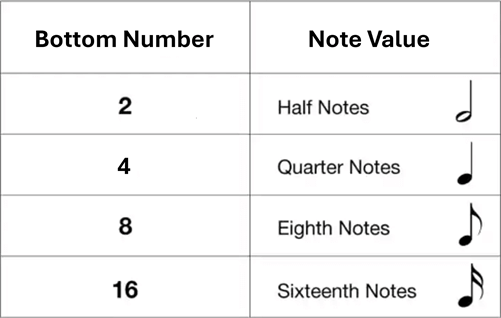Rhythmic structure
Bar
This is how a bar looks in our notation:
It is basically a grid of 4 rows by X columns, where each column represents a beat subdivision. In the image above we have 4 beats with 4 subdivisions each, hence 4 x 4 = 16 columns. If we were to count the rhythm (as explained in the previous section) it would look like that:

Beat subdivisions
While 4 beat subdivisions is the most common structure in handpan music, any number is possible. The most frequently used are: 2, 3, 4, 6 and 8.
Beats are independent, meaning each beat has its own number of subdivisions which can be different from the other if needed.
2 subdivisions
3 subdivisions
6 subdivisions
4 - 8 - 4 - 3 subdivisions
Just a random example to showcase the flexibility of the notation.
Even though the beats are visually different in size, remember that they have the same duration! The subdivisions of a beat divided in 8 are half the duration of the ones in a beat divided in 4, the total is the same.
Go further : split subdivision
Our notation system adds even more flexibility to subdivide a beat, with the possibility to split a single subdivision in 2 even parts.
Notice the tiny vertical bar that separates the two split columns: this is the notation that helps you recognize this feature.
This feature is mostly used for visual convenience when you need to write a fast right-left pattern. Take the following sequences for example: they are rhythmically identical but the second one (which uses a split subdivision) is more compact and more readable.
Time signature
Until now all examples had a 4/4 time signature, but you can of course write more complex rhythm structure. If you don't know what a time signature is, take a look at the definition below before reading the rest of the section.
Definition
In music notation, the time signature tells you how many beats are in each bar, and which note value to count as a beat. You can find the time signature at the beginning of a sheet music, and it looks like that:

It consists of 2 numbers written like a fraction:
- The top number is the number of beats in each bar. This could be any number, but most often falls between 2 and 12.
- The bottom number tells you which note value counts as a beat, see the table below:

The most common time signature is 4/4. Here are some of the most used for instance:
- 4/4: 4 beats per bar / each beat is a quarter
- 3/4: 3 beats per bar / each beat is a quarter
- 2/4: 2 beats per bar / each beat is a quarter
- 6/8: 6 beats per bar / each beat is a eighth
- 12/8: 12 beats per bar / each beat is a eighth
Because the concept of note value (whole, half, quarter, eighth, etc) doesn't exist in our notation system, the bottom number of the time signature is not relevant to us. The only information we need is the number of beats per bar.
Consequently, the notations for X/2, X/4, X/8 and X/16 time signatures actually all look the same. For example, you would write a 6/8 pattern the same way you write a 6/4 pattern.
3 beats par bar
5 beats par bar
7 beats per bar
If you really want to make a distinction between a X/4 and a X/8 time signatures, you can play with the number of subdivisions. In X/8 you don't need 4 subdivisions per beat most of the time, so you're fine with using only 2.
For example, this is how I would write a 6/4:
And this is how I would write a 6/8: